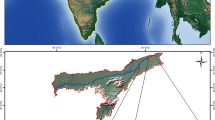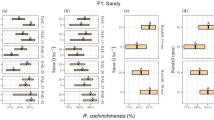Abstract
Changes in the content, reserves, and composition of humus in a sandy gleyic iron-humus-illuvial soddy-podzolic soil under intensive, decreasing, and ceased agrotechnical impacts were studied. It was shown that when a well-cultivated soil is removed from economic use, the conditions of humus formation in the former homogeneous plow layer develop differently. A deterioration of the humus status parameters of the layland soil was found as compared to the cultivated soil. It was concluded that, when a soil is removed from economic use, its profile, which was disturbed by the anthropogenic impact, tends to return to the original genetic state. The change in the level of the agricultural practices affected the optical density of the humic acids only slightly, which is indicative of their relative stability under specific soil-forming conditions.
Similar content being viewed by others
References
I. L. N. Aleksandrova, Soil Organic Matter and Its Transformation (Nauka, Leningrad, 1980) [in Russian].
D. P. Andreev, S. N. Chukov, and V. V. Yakovleva, “Transformation of Plow Horizons in Fallowed Soddy-Podzolic Soils on Sandy Parent Rocks,” in Proceedings of the IV Congress of the Dokuchaev Society of Soil Science, Novosibirsk, Russia, 2004 (Novosibirsk, 2004), Vol. 1, p. 90 [in Russian].
R. A. Afanas’ev, “Role of Comparative Ecosystems in the Protection of Soils from Degradation,” Kormoproizvodstvo, No. 4, 5–7 (2001).
V. R. Williams, Agriculture with fundamentals of Soil Science (Sel’khozgiz, Moscow, 1936) [in Russian].
N. F. Gomonova and M. F. Ovchinnikova, “Effect of Long-Term Mineral Fertilization and Liming on the Chemical Properties and the Group and Fractional Composition of Humus,” Agrokhimiya, No. 1, 85–90 (1986).
L. A. Grishina, Humification and the Humus Status of Soils (Mosk. Gos. Univ., Moscow, 1986) [in Russian].
V. N. Efimov and A. I. Ivanov, “Latent Degradation of Well-Cultivated Soddy-Podzolic Soils of Russia,” Agrokhimiya, No. 6, 5–10 (2001).
A. A. Korotkov, Candidate’s Dissertation in Agriculture (Leningrad, 1958) [in Russian].
M. A. Kostenko, “Change of the Active Soil Layer Depending on the Age of Grasses,” in Collection of Scientific Papers Devoted to the 100th Birthday of M. A. Andreev (Moscow, 2000), pp. 321–328 [in Russian].
A. V. Litvinovich, Extended Abstract of Candidate’s Dissertation in Agriculture (Leningrad, 1986).
A. V. Litvinovich, Doctoral Dissertation in Agriculture (St. Petersburg, 2005).
A. V. Litvinovich, O. Yu. Pavlova, and D. V. Chernov, “Changes in Parameters of Soil Fertility and Labile Humus Component of Sandy Soddy-Podzolic Soil under Intensive Cultivation and Economic Exhaustion,” Agrokhimiya, No. 4, 14–21 (2003).
V. G. Mineev, N. F. Gomonova, and M. F. Ovchinnikova, “Stability of Soddy-Podzolic Soil Fertility Caused by the Long-Term Application of Agrochemicals,” Agrokhimiya, No. 6, 14–21 (2003).
N. E. Orlova and L. G. Bakina, “Current Humus-Formation Processes in Cultivated Soddy-Podzolic Soils of the Northwestern Russia,” Agrokhimiya, No. 11, 5–12 (2002).
N. E. Orlova, L. G. Bakina, and L. E. Dmitricheva, “Transformation of Organic Matter of Soddy-Podzolic Soil during the Decreasing of Agricultural Level,” in Humus and Podzolization (St. Petersburg, 2000), pp. 72–76 [in Russian].
N. E. Orlova, L. G. Bakina, and T. A. Plotnikova, “Internation of Humic Acids with Calcium and Soil Liming,” Pochvovedenie, No. 1, 120–123 (1992).
V. K. Pestryakov, Cultivation of Northwestern Soils (Kolos, Leningrad, 1977) [in Russian].
T. A. Plotnikova, “Characterization of the Formation Features and Nature of Humus Substances Using Optical Density,” in Geography, Genesis, and Fertility of Soils (Kolos, Leningrad, 1972), No. 4, pp. 196–200 [in Russian].
V. V. Ponomareva and T. A. Plotnikova, Humus and Pedogenesis (Nauka, Leningrad, 1980) [in Russian].
T. A. Plotnikova and N. E. Orlova, “Use of the Modified Ponomareva-Plotnikova Procedure for Determining the Composition, Nature, and Properties of Soil Humus,” Pochvovedenie, No. 8, 120–128 (1984).
A. P. Safonov, S. P. Mel’nikov, and V. A. Ilyushchenko, “Humification in Plowed Soddy-Podzolic Soils of the Northwestern Regions of Russia,” Pochvovedenie, No. 1, 120–128 (1992).
I. V. Tyurin, “Characterization of the Soddy Pedogenesis Process,” in V. R. Williams, Festschrift (1935).
A. S. Fomina, Extended Abstract of Candidate’s Dissertation in Agriculture (St. Petersburg, 2005).
D. V. Chernov and E. A. Kirillova, “Morphological Features of Loamy Virgin, Plowed, and layland Soils,” in Humus and Pedogenesis (St. Petersburg, 2000), pp. 145–152 [in Russian].
L. K. Shevtsova, Extended Abstract of Doctoral Dissertation in Biology (Moscow, 1988).
Author information
Authors and Affiliations
Additional information
Original Russian Text © A.V. Litvinovich, O.Yu. Pavlova, 2007, published in Pochvovedenie, 2007, No. 11, pp. 1323–1329.
Rights and permissions
About this article
Cite this article
Litvinovich, A.V., Pavlova, O.Y. Changes in the humus status of a layland sandy gleyic soddy-podzolic soil. Eurasian Soil Sc. 40, 1181–1186 (2007). https://doi.org/10.1134/S1064229307110051
Received:
Accepted:
Issue Date:
DOI: https://doi.org/10.1134/S1064229307110051




